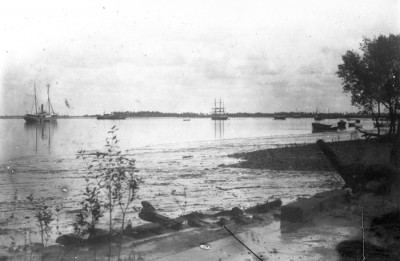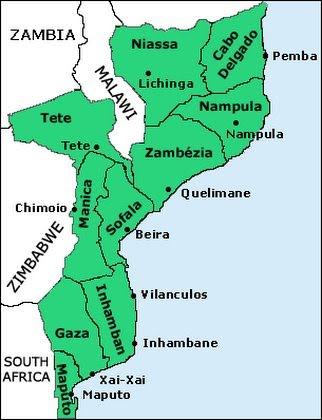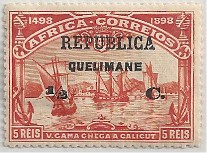ALBUM – View my Quelimane, Portuguese Colonial Province album
TRANSITION CHART – Mozambique Area
Fast Facts
Region: Southern Africa
Group: Mozambique Area
Classification: Colony, Portuguese
Prior Regime: Province of Zambezia
Key Dates:
1498, Mar 1 – Vasco da Gama lands on Mozambique Island and “claims” the region of Portugal
1544 – Settlement at Quelimane founded
1752 – Colony of Moçambique, Zambesi and Sofala separated from Portuguese India in Goa
1892, May 20 – Zambezia Company concession created
1894 – Zambezia Province established by combining Tete and Quelimane
1920 – Tete was split from Zambezia to form two separate provinces.
Following Regime: Portuguese Mozambique Colony
Scott Catalogue: (Quelimane) #1-40
Pick Catalogue: none
Currency: 100 centavos = 1 escudo
History

Vasco da Gama, on his monumental voyage around the Cape of Africa to India, landed in Mozambique on 1 Mar, 1498 and “claimed” the area for Portugal. Portuguese activity began in 1505, and in 1544, a settlement was founded at Quelimane. Throughout the 16th, 17th, and much of the 18th century, Mozambique was not well developed, as it was used more as a stopping off for ships going to and from India.
Until 1752, Portugal’s possessions on East Africa’s coast were administered by Portuguese India in Goa, but this changed when the region was placed under a Captain General who resided in the City of Mozambique. The Portuguese began to trade slaves (mainly destined to the French Mascarene islands, Mauritius and Reunion). With the loss of Brazil in 1822, and the slave trade being outlawed, Portugal began focusing more on its African possessions. Although the slavery was outlawed in Europe, the Portuguese continued a very lucrative slave trade with the Arabs and Ottomans until 1877.
During the Scramble for Africa in the 1880s, Portugal had to cede much of the territory it claimed in East Africa to Cecil Rhodes’ British South Africa Company and British East Africa Company, however Portugal’s claim over Mozambique was affirmed by the Berlin Conference of 1885. At this time, Mozambique’s infrastructure was developed with much assistance from the British, as both British Central Africa/Nyassaland and Northern Rhodesia both depended on railroads and roads connecting these areas with the ports of Beira and Mozambique.
 In 1891 the Portuguese shifted the administration of much of the country to large private companies which were granted control over mining, fishing, infrastructure, communications and taxing locals. The largest charters were given in 1891 to the Mozambique Company to administer the southern part of the country from Beira for 50 years and the British owned Nyassa Company for 35 years to control the territory north of the Lurio River. In 1892, the Zambezia Company was also established to administer the middle area of the country around the mouth of the Zambezi River. While the Zambezia Company was never officially chartered, it became the largest of the three.
In 1891 the Portuguese shifted the administration of much of the country to large private companies which were granted control over mining, fishing, infrastructure, communications and taxing locals. The largest charters were given in 1891 to the Mozambique Company to administer the southern part of the country from Beira for 50 years and the British owned Nyassa Company for 35 years to control the territory north of the Lurio River. In 1892, the Zambezia Company was also established to administer the middle area of the country around the mouth of the Zambezi River. While the Zambezia Company was never officially chartered, it became the largest of the three.
Quelimane is a seaport which lies near the mouth of Rio dos Bons Sinais and is the capital of the Mozambique province of Zambezia. As one of the oldest settlements it the region, functioning as a Portuguese trading port beginning in 1544, Quelimane eventually became one of the most active slave trading ports in the region during the 18th and 19th century. Until the late 1800’s, Quelimane also functioned as a gateway city to the Zambezi River for trade and exploration.
In 1894, Quelimane and the surrounding region was joined with the area of Tete to form the province of Zambezia, with Quelimane as its capital. During the life of this province, great upheaval was experienced in Portugal. On 5 Oct, 1910, a coup d’état was organized by the Portuguese Republican Party which ultimately deposed the constitutional monarchy and established a republican regime in Portugal. This can be seen in the stamps issued in the Province, as they were overprinted “REPUBLICA”.
In 1920, Tete was split off, forming the two separate provinces of Zambezia (with Quelimane as it capital) and Tete.
Stamps
 ALBUM
ALBUM
During this time period, the colony of Mozambique was not yet centralized and communication between the various Portuguese outposts was difficult. Therefore, the individual provinces of Mozambique: Inhambane (1895-1914), Lourenço Marques (1895-1920), the city of Quelimane (1913-1922), Tete (1913-1914), and Zambezia (1894-1917) issued their own stamps, as did the Mozambique Company (1891-1942) and the Nyassa Company (1897-1929).
In 1913, the city of Quelimane issued it’s first stamps. As with many other Mozambique provinces, the Vasco da Gama issues (8 denominations) from 3 different Portuguese Colonies (Macao, Portuguese Africa and Timor) were surcharged with the new currency of Portugal and overprinted “REPUBLICA” and “QUELIMANE”.
In 1914, these stamps were replaced with the common Portuguese Ceres design. This design was used in Portugal and throughout the Portuguese colonial empire. Fifteen separate denominations were issued from 1/4c to 1e.
When Tete was split off from Zambezia to form separate provinces in 1920, stamps of Zambezia, Tete and Quelimane were replaced by stamps of Moçambique Colony.
Banknotes
Portuguese currency was used in Quelimane
Links
History of Mozambique – Hubert de Vries heraldry
The British Ultimatium of 1890





The information was great. I wish I knew who wrote it so I could give them credit for the parts that I used.
Hi William. Thank you for visiting DCStamps. While the information came from a variety of places, I put together the final write up.
Michael